Beef Lean Muscle to Fat Content Average
Final Updated on May viii, 2021 by
A generation or two ago, our parents and grandparents viewed beef as a nutritious health food.
These days it all seems much different, and opinion is carve up between whether beef is healthful or harmful for our health.
This article takes an in-depth look at the nutrition profile and potential wellness benefits of beefiness, which is a type of red meat.
Additionally, nosotros expect at some of the potential concerns.
1. Beefiness has an impressive nutrition profile
First of all, beefiness is an splendid source of essential nutrients. It contains a broad range of vitamins and minerals.
The following data shows the full nutritional values for beef per 100 grams, based on information from the USDA's FoodCentral Database.
Although the exact nutrient values volition depend on the precise cut of meat, the following information is based on 80% lean ground meat (1).
| Calories/Nutrient | Amount |
|---|---|
| Calories | 254 kcal |
| Carbohydrate | 0 g |
| Fat | 16.17 one thousand |
| Saturated fatty | 6.16 g |
| Monounsaturated Fatty | seven.nineteen g |
| Polyunsaturated Fatty | 0.47 g |
| Poly peptide | 25.25 g |
Vitamins
- Vitamin B12: 104% DV
- Niacin (vitamin B3): 29% DV
- Vitamin B6: 19% DV
- Choline: fifteen% DV
- Riboflavin (vitamin B2): 13% DV
- Pantothenic acrid (vitamin B5): 11% DV
- Thiamin (vitamin B1): three% DV
- Folate: 2% DV
- Vitamin E: ane% DV
- Vitamin K: one% DV
Minerals
- Zinc: 57% DV
- Selenium: 37% DV
- Phosphorus: fourteen% DV
- Iron: 14% DV
- Potassium: 6% DV
- Magnesium: 5% DV
- Copper: 9% DV
- Sodium: 3% DV
- Calcium: 2% DV
- Manganese: 0.v% DV
Key Point: Beef is a rich source of protein, B vitamins, zinc, and selenium.
ii. Beefiness provides a large source of 50-Carnitine
L-carnitine is a health-promoting compound that the body synthesizes in the liver from the amino acids lysine and methionine (ii).
Beef is the best dietary source, and other meat products too contain relatively high amounts (3).
In the tabular array below, we tin can see the L-carnitine content of beefiness compared to another animal foods and plant foods (4);
| L-Carnitine Nutrient Source | Amount of L-Carnitine (mg) |
|---|---|
| Asparagus (1/ii loving cup) | 0.1 |
| Beef (4oz) | 56 – 162 |
| Cheese | 2 |
| Craven Chest (4oz) | iii – v |
| Cod (4oz) | 4 – seven |
| Ice-Cream (1/2 loving cup) | 3 |
| Whole Milk (1 cup) | eight |
| Whole Wheat Staff of life (ane slice) | 0.two |
Why is L-Carnitine Important?
Among its numerous functions, L-carnitine plays a role in fatty metabolism.
As part of this, 50-Carnitine does the job of transporting fats into our mitochondria where we burn down them (5).
It'south important to clarify that our body tin synthesize sufficient amounts of L-carnitine for general needs, and we don't necessarily need an external intake.
Every bit a consequence, deficiencies are rare.
However, inquiry suggests that a college dietary intake of L-Carnitine may have some positive health impacts.
Middle Health
A meta-analysis of randomized trials suggests that L-carnitine improves patient outcomes. Specifically, it exerts an effect on hypertension, oxidative stress, nitric oxide, and inflammation (3).
A farther systematic review found that L-carnitine is associated with a 27% reduction in all-cause mortality in middle failure patients (iv).
Diabetes
A systematic review shows that college L-carnitine intake in type two diabetes patients improves fasting glucose levels and the overall cholesterol contour (five).
Weight Loss
According to a systematic review and meta-assay of nine randomized controlled trials, subjects using L-carnitine supplementation lost "significantly more than weight" than the command grouping (6).
Withal, it is of import to annotation that each of these benefits was noted in participants taking supplementary carnitine.
In other words, we tin can't automatically presume that the amounts nowadays in beef would have the aforementioned potential benefits.
On the other mitt, research demonstrates that the absorption rate of carnitine from supplements is poor in comparison to beef.
Supplementary doses of constructed carnitine are usually around 500-600 mg, of which our torso simply absorbs fourteen-18% of the chemical compound (7).
By comparison, beefiness provides 56-162 mg of carnitine per iv oz (112-gram) serving. According to existing trials, dietary carnitine has a bioavailability of approximately 54-87% (7).
Key Signal: 50-carnitine is a compound that naturally occurs in beefiness. Based on enquiry into carnitine supplementation, it seems to have a positive touch on diverse wellness markers.
3. Beef Provides the "Main Antioxidant" Glutathione
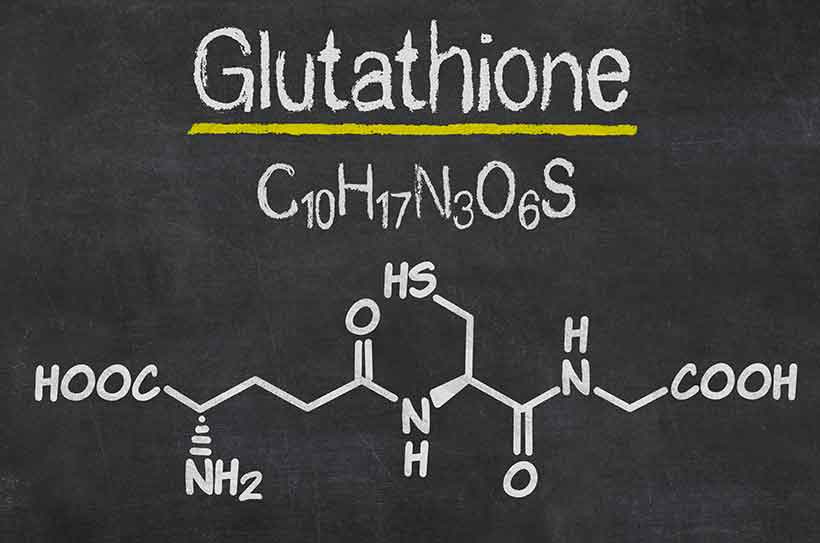
Commonly known equally the 'principal antioxidant,' glutathione has a score of research linking it to (8);
- Anti-aging benefits
- Increasing longevity
- Preventing illness
- Reducing the hazard of chronic disease
- Strengthening the immune system
As a key player in the homo immune organization, glutathione helps to protect every prison cell in our body from cellular harm, which tin can lead to many chronic diseases.
On the other hand, a deficiency in glutathione appears to contribute to oxidative stress and inflammation (9).
Every bit a result, maintaining sufficient glutathione levels seems to be important for human wellness.
Endogenous Glutathione Product and Dietary Sources
Firstly, the human torso produces glutathione endogenously.
In other words, our body uses raw materials (in this case: amino acids) to brand glutathione.
For this process to occur, the trunk requires adequate levels of the amino acids cysteine, glutamate, and glycine (x).
These amino acids are known as glutathione precursors, and each of these amino acids is nowadays in beef.
On the positive side, beef also contains a reasonably loftier source of complete (preformed) dietary glutathione (11, 12).
Fundamental Point: Keeping our glutathione levels high is critical for skilful health, and beef is a food that may help us to achieve this.
four. Beef is High in Protein
There are numerous reasons why we should strive to ensure a sufficient protein intake and these include;
- Amino acids (proteins) are the edifice blocks our body uses to repair and make bone, peel, and cartilage (13).
- Sufficient protein intake helps united states to build and maintain lean muscle mass (fourteen).
- Out of all macronutrients, dietary protein appears to be the about satiating, and it may aid to discourage nutrient cravings (15).
Beef is packed with amino acids, and information technology is one of the most complete sources of protein in the human diet (16).
For instance, a cooked 6 oz (170g) portion of lxxx% lean beef provides 36.five grams of poly peptide (i).
Should we opt for a bacteria diversity of beef, the protein content can be fifty-fifty higher. For 95% lean basis beef, a cooked 6 oz (170g) serving provides 43 grams of protein (17).
It is besides worth noting that, as a dried/full-bodied source of beef, hasty is a rich source of poly peptide.
The Importance of Lean Mass
Every bit we age, building—orat least belongings on to—lean mass should be a priority.
Enquiry shows that older adults with lower muscle mass are at a higher risk of mortality.
Speaking frankly, the more than skeletal muscle mass someone loses equally they age, the college their risk of an earlier death (12).
Too, the charge per unit of muscle protein synthesis chop-chop drops as we age, making it a lot harder to build and maintain muscle (xiii).
Considering this, we should ensure we're eating a sufficient amount of protein – this is especially essential for elderly people.
On this note, beef is 1 of the best poly peptide-rich foods out there.
Key Bespeak: Protein is essential for optimal wellness, and specially then as we age. Beefiness provides an arable amount of this macronutrient.
4. Beef is Rich in Minerals
If y'all're looking to increase your intake of diverse minerals, then beefiness is one of the best options to consider.
Showtime of all, beefiness is relatively nutrient-dumbo in minerals.
Hither nosotros can see the mineral content of fourscore% lean beef (11);
| Mineral Name | Amount per 6oz portion (% DV) |
|---|---|
| Calcium | 4 |
| Copper | viii |
| Iron | 26 |
| Magnesium | 10 |
| Manganese | 2 |
| Potassium | xviii |
| Phosphorus | 38 |
| Selenium | 52 |
| Zinc | 72 |
As shown in the tabular array, beefiness provides more than half of the twenty-four hour period'due south recommended corporeality of selenium and zinc.
Many people have deficiency issues with some of these minerals.
So, the nutritional value of beef can help fight prevalent global deficiencies in iron, magnesium, and zinc (14, 15, 16).
Primal Point: Beef is rich in several essential minerals—especially fe, phosphorus, selenium, and zinc.
5. Eating Beef Helps To Prevent Fe Deficiency Anemia
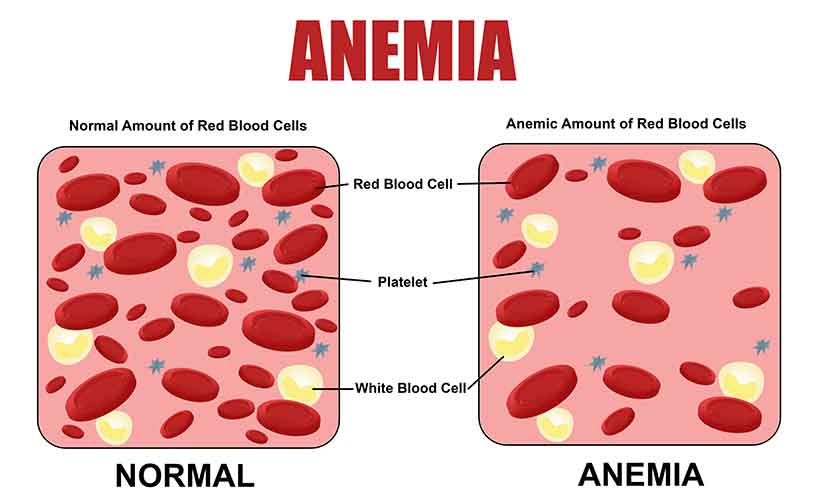
We touched on mineral deficiencies in the last point, simply iron deficiency anemia deserves a mention of its own.
Sadly, fe deficiency anemia is a growing epidemic around the globe.
In a developed state such as the United States, nutrient deficiencies shouldn't be a cause of death, nonetheless anemia kills thousands every year.
To be exact, the latest release of statistics showed that Anemia hospitalized 146,000 Americans in 1 year. 5,219 of these people died (17).
Globally it's even worse, and according to the World Health Organization, 1.62billion people endure from iron deficiency anemia (18).
Heme and Non-Heme Iron
There are ii types of fe available in food, and nosotros refer to them as heme and non-heme iron.
- Heme Iron:Heme iron is the most bioavailable form of iron, and meat and other fauna foods exclusively comprise it.
- Non-Heme Fe: Not-heme iron is plant in institute foods such every bit fruit, vegetables, and basics. In comparison to heme atomic number 26, our trunk finds it more than difficult to absorb.
One of the best health benefits of beef meat is that it contains a substantial amount of heme atomic number 26.
The best source of all? Beef liver.
Interestingly, anemia disproportionately affects females. Perhaps this isn't a huge surprise when we recall about how social club seems to shame women who swallow meat.
The imagery of women smiling while eating a bowl of salad is quite ubiquitous.
Key Indicate: Eat more beef to help prevent iron deficiency anemia.
6. Beef Contains Carnosine
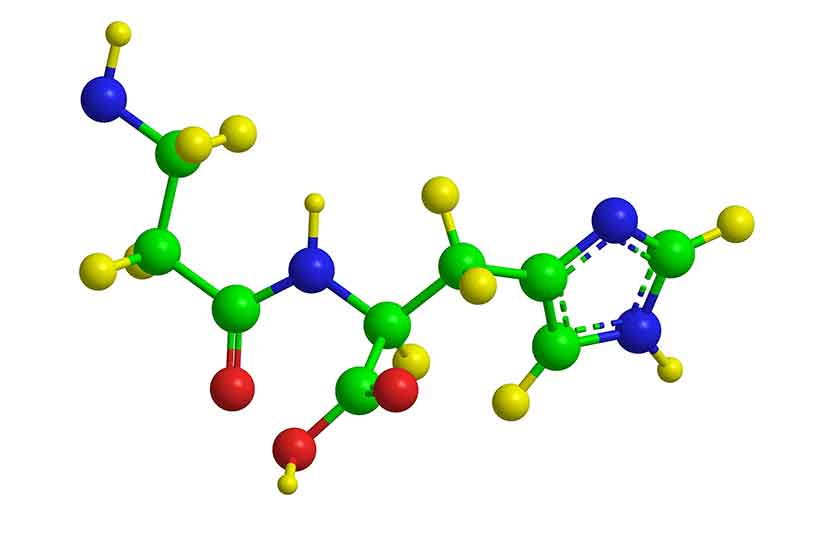
Some other potential advantage of eating beef is that it provides an abundance of carnosine.
Carnosine (beta-analyl-L-histidine) is a compound created by the combination of the amino acids alanine and histidine. It is found throughout the trunk, and it has several important roles in human health.
Equally beef is 1 of the highest sources of carnosine (containing about l% more than poultry), this is another health do good.
What Does Carnosine Do?
For one matter, carnosine has anti-glycosylation properties.
To be exact, carnosine reduces the harms of a process called 'glycation' which involves avant-garde glycation end-products (AGES).
Glycation is central to the aging procedure and progressively damages our torso, potentially leading to atherosclerosis and various other chronic diseases (19, xx).
Additionally, carnosine helps boost the allowed organization and reduce inflammation. The compound is likewise thought to help preclude lipid peroxidation within our cells (21, 22).
Key Point: Beefiness (and red meat in full general) is the best dietary source of carnosine.
7. Beef is Full of Vitamins
There are many important nutrients in beef, and those nowadays in significant amounts include the range of B vitamins (11);
| Vitamin Name | Amount Per 6oz Portion (% RDI) |
| Vitamin B12 | 82 |
| Vitamin B3 | 50 |
| Vitamin B6 | 36 |
| Vitamin B2 | 18 |
| Vitamin B5 | 14 |
Additionally, beefiness as well contains smaller amounts of vitamins E and Grand.
Vitamin B12 (cobalamin) is a notably essential nutrient, and this is because information technology is simply available from animal foods.
This vitamin also has a wealth of benefits that include skin improvements, positive mood, better sleep, and neural regeneration (23, 24).
It's important to realize that insufficient vitamin B12 may also increase the run a risk of depression and mental health issues (25, 26).
Fortunately, but 100 grams of beef provides the daily recommended amount of B12.
Primal Point: Beefiness is high in B vitamins which help promote health. Vitamin B12 is particularly important since it isn't present in plant-based foods.
8. Conjugated Linoleic Acid
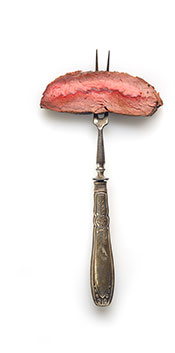
Otherwise known as CLA, conjugated linoleic acid is a naturally occurring trans-fat.
Don't worry, although the "trans-fat" name is a little scary, information technology has a very unlike effect to the synthetic version.
Some randomized controlled studies involving man participants suggest that;
- Conjugated linoleic acid might assist to improve insulin sensitivity (27)
- CLA may slightly promote fat loss, but the evidence is mixed (28, 29)
Notably, the majority of the evidence suggests that getting CLA from real food is amend than supplementation (30).
As is oft the case, possibly nutrients in whole foods have a unlike outcome to a synthetic pill?
Food Sources of CLA
The top sources of CLA include meat and dairy products.
Later on lamb meat and certain cheeses, beefiness is the next highest provider of the food.
Although all types of beef contain CLA, grass-finished meat offers a significantly higher amount than beef from grain-fed cattle.
Specifically, the average corporeality of CLA in grass-fed beef is 0.46% of the fatty content.
With grain-fed beefiness, this boilerplate content drops to 0.16% of fat (31).
Key Point: Beef—especially from grass-fed cows—is ane of the highest sources of conjugated linoleic acid.
ix. Beef Contains Creatine
Almost everyone knows the dietary supplement version of creatine, but did y'all know that beef contains information technology likewise?
In fact, beef typically contains 350mg creatine per 100g (32).
The health benefits that creatine bring include;
- Improved exercise performance
- Creatine assists in muscle growth and development
- Provides muscles with greater energy supply and improves endurance
- Increased muscular size
Information technology'south besides worth noting that our liver can produce about 2g creatine per day, depending on the pre-cursors being available.
Creatine precursors include arginine, glycine, and methionine (33).
Non only are all of these amino acids present in beef, but beefiness is ane of the unmarried most significant dietary sources for them.
In other words, eating beef gives you a decent amount of dietary creatine, and it helps your body to produce it also.
Key Point: Beef has two positive impacts on creatine levels. Firstly, information technology directly provides information technology to the body and secondly, it helps the torso to make it.
Final Thoughts
Beef contains several wellness-promoting compounds, some of which many of united states don't consume in sufficient amounts.
While there are too some concerns most blood-red meat worth considering, beef supplies large amounts of beneficial nutrients to the average nutrition.
Specially protein, iron, zinc, and vitamin B12.
Related Articles
Is Steak Salubrious?
The Steak and Eggs Nutrition: An Old-School Diet For Weight Loss?
Source: https://www.nutritionadvance.com/health-benefits-eating-beef/
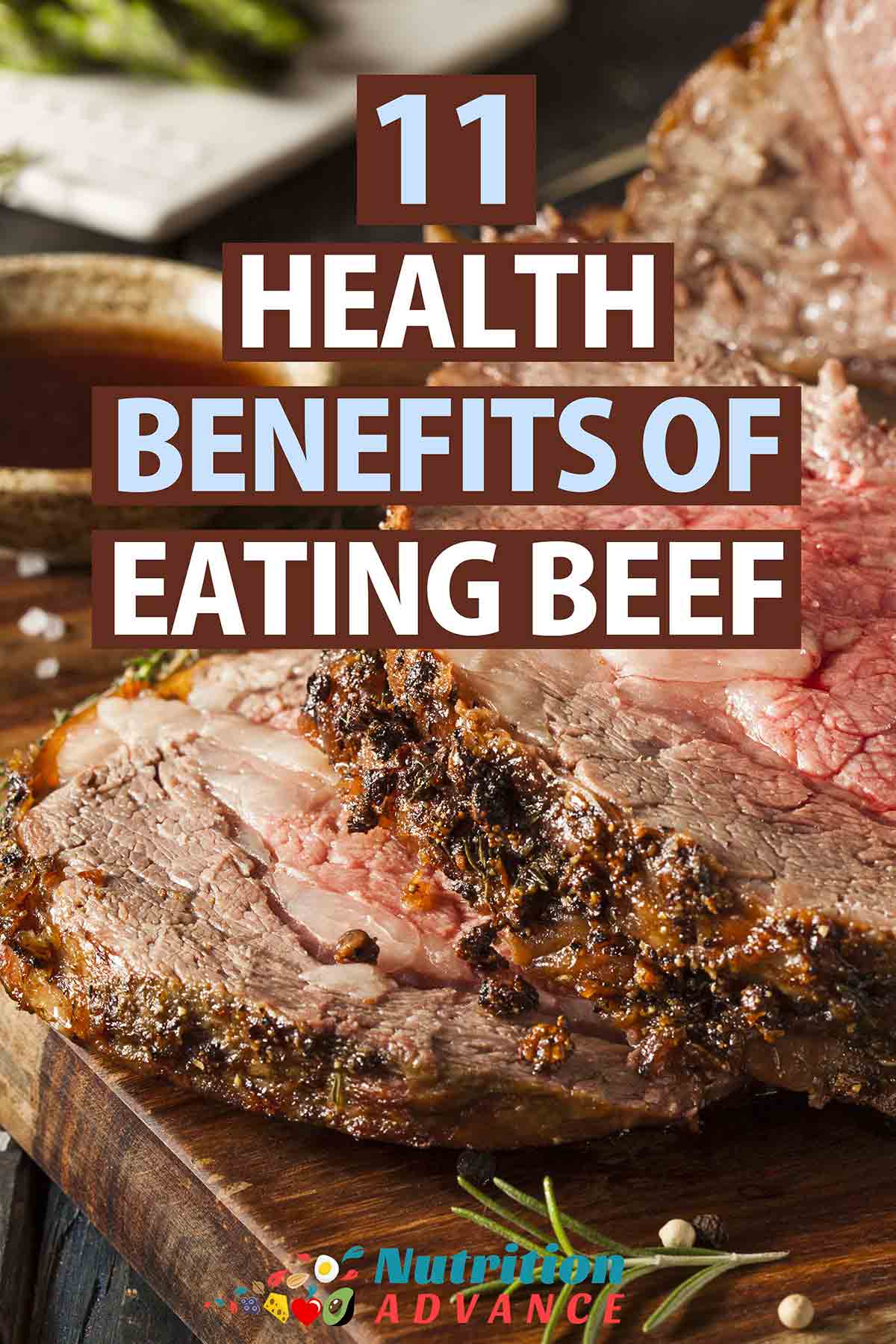
0 Response to "Beef Lean Muscle to Fat Content Average"
Post a Comment